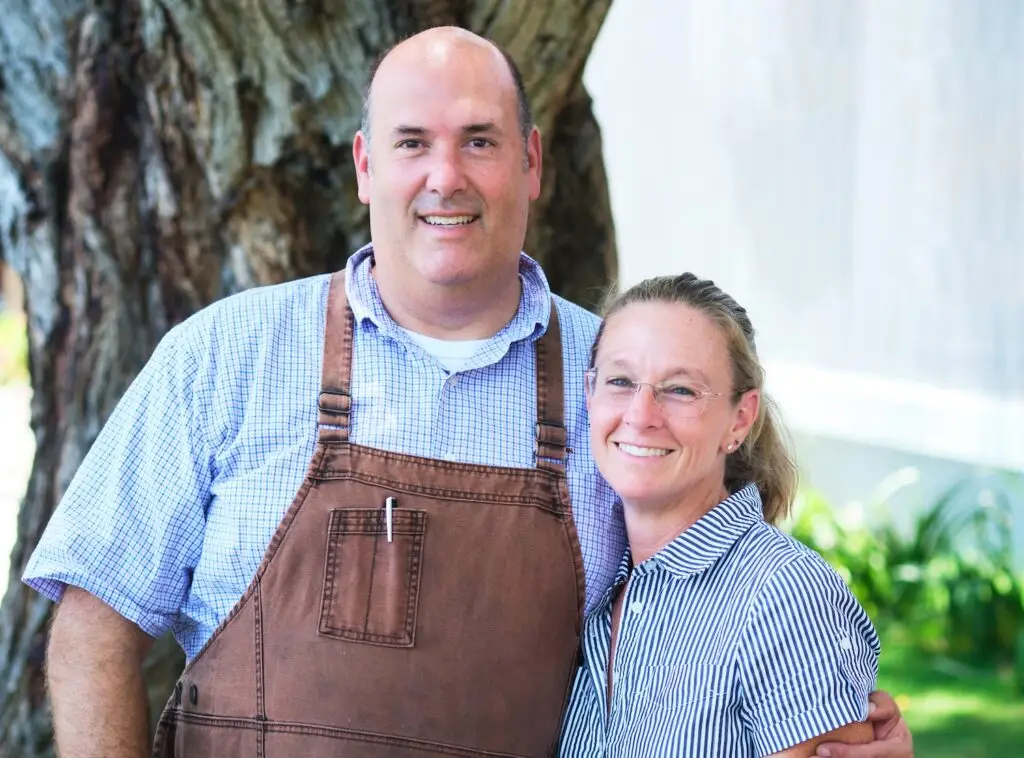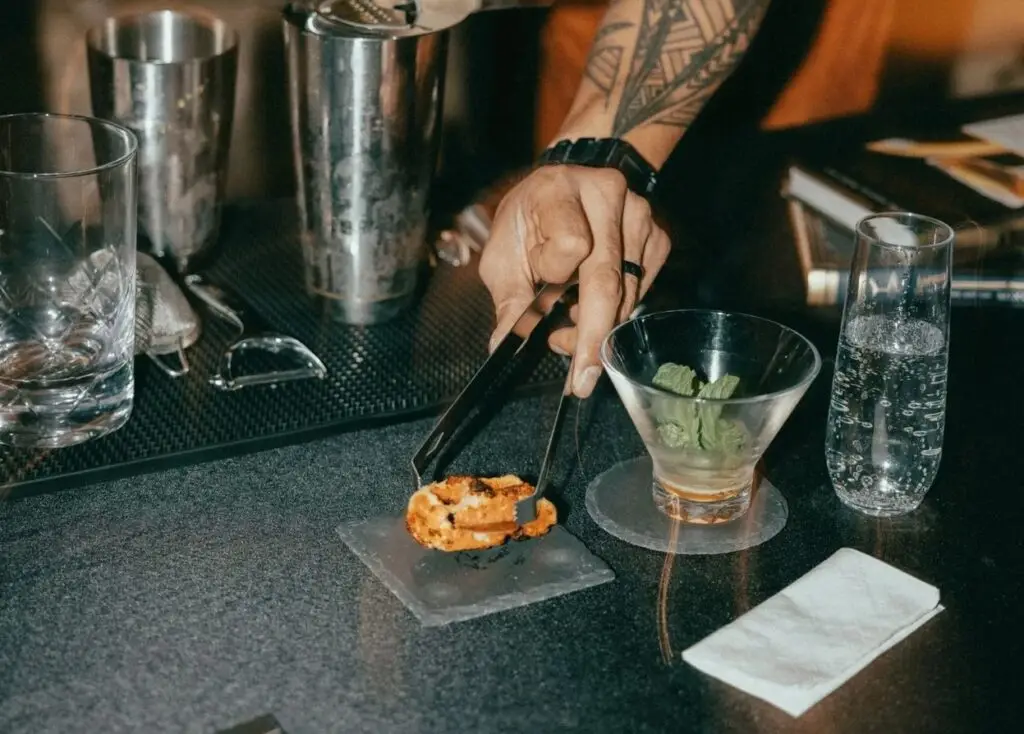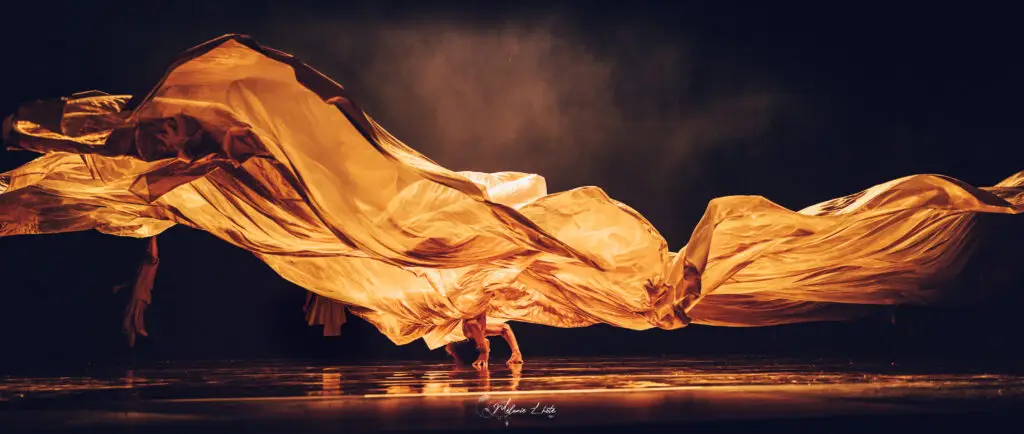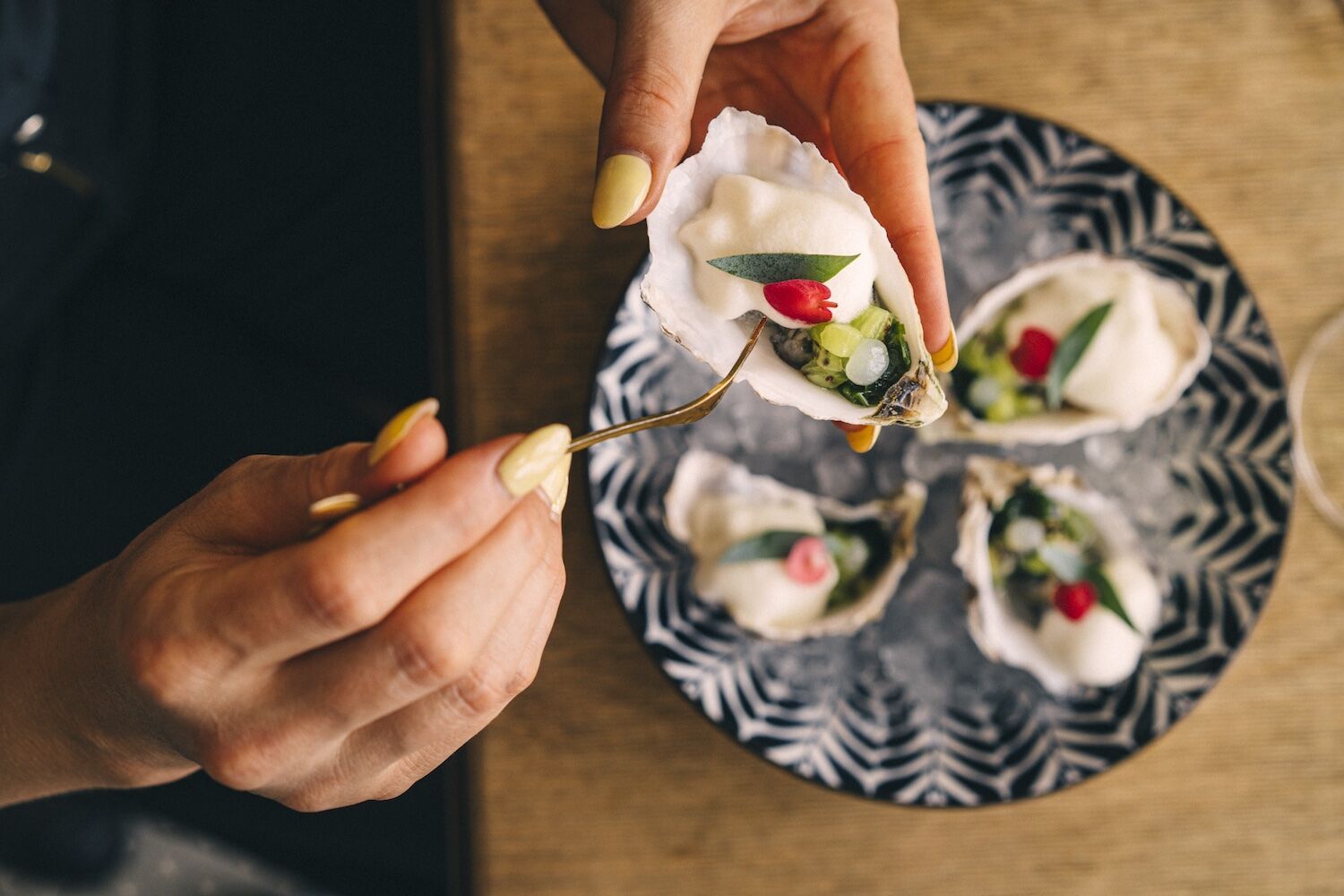
Fresh oysters with lemon, salted kiwi, and absinthe foam
Photo Credit: Eric Wolfinger
I can speak French in this room.
I can’t really speak French, maybe 10 words or so, which all fall from my mouth in a confusing language pile. But in the sexy French bistro that is Wormwood, logic and skill are no match for the way it makes you feel. I am fluent. I am not me, a person raised in the cultural khaki-pants-ness of suburban Southern California, wearing but-of-course jeans and a button up that suggests an active distaste for fashion. My no-name clothes are Gautier and I may well be Proust, casually sniffing the air for bone marrow and French 75s.
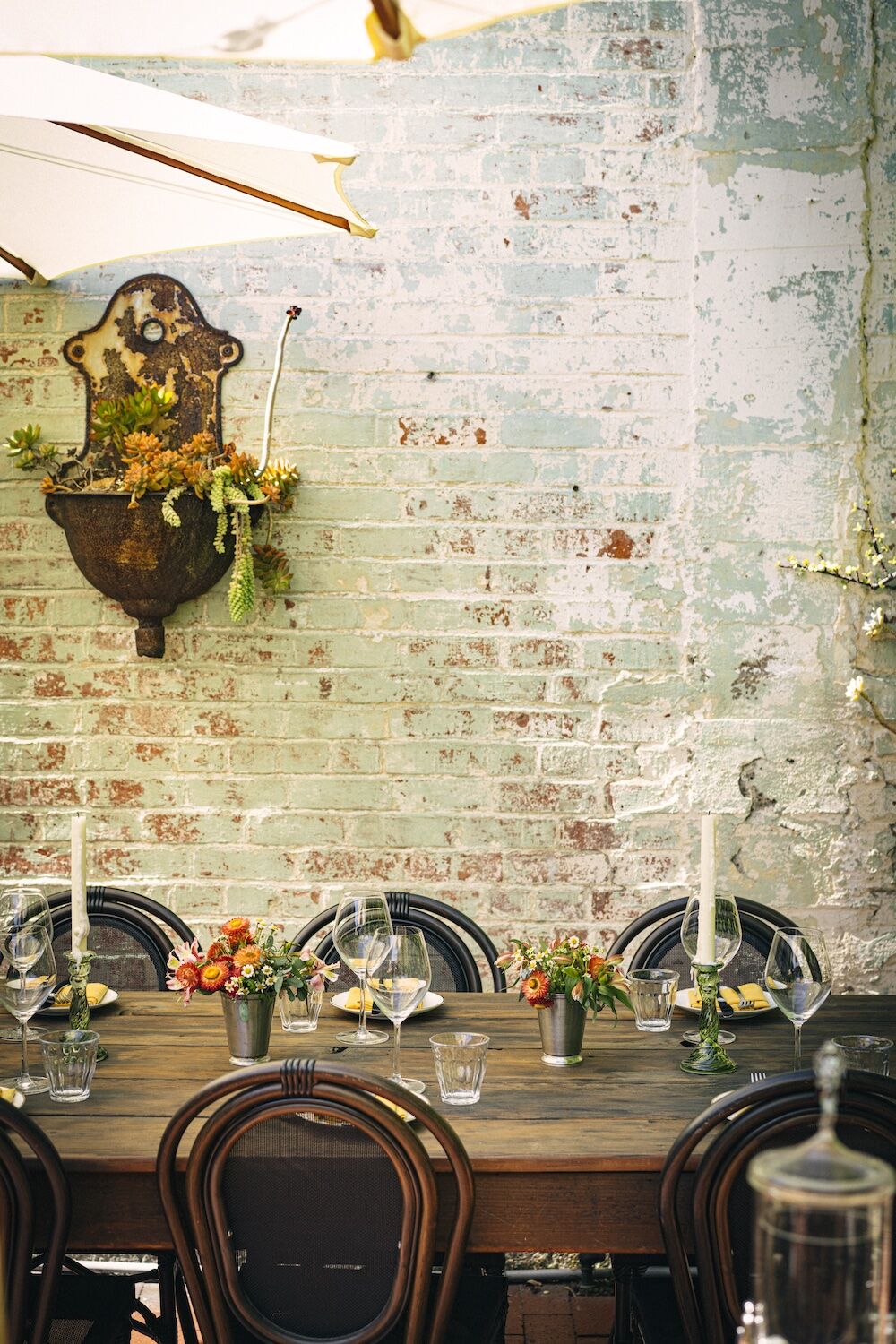
The patio at Wormwood in North Park is about as charming of an urban oasis as you can find—a whole other, better world
Photo Credit: Eric Wolfinger
The mid-afternoon light is abusive through the tiny windows of the minuscule Adams Avenue restaurant. We are eating in a solar flair. And somehow, that minor first-world suffering also feels a bit magical. On the verdant, shaded plant-wall patio out back—which has been the somewhat secret oasis of central San Diego for over a decade, when this place was the beloved Jayne’s Gastropub—two jazz musicians lightly strut and pluck while diners slurp oysters with absinthe foam. There’s an old wooden piano. If you’re not charmed, you may be a bit broken in places.
Wormwood is the newest project from the owners of mezcal haven Tahona, a mezcaleria-slash- Mexican restaurant that brought a little modernity to Old Town. Like their first project, this house is organized around spirits. First, the spirit of Jaynes, whose gift for elegant quainthood still lingers. There are new flairs—massive mirrors, slick faux taxidermy—but the subway-tiled floors and dark wainscotting are still there, the soul of a much-missed icon preserved.
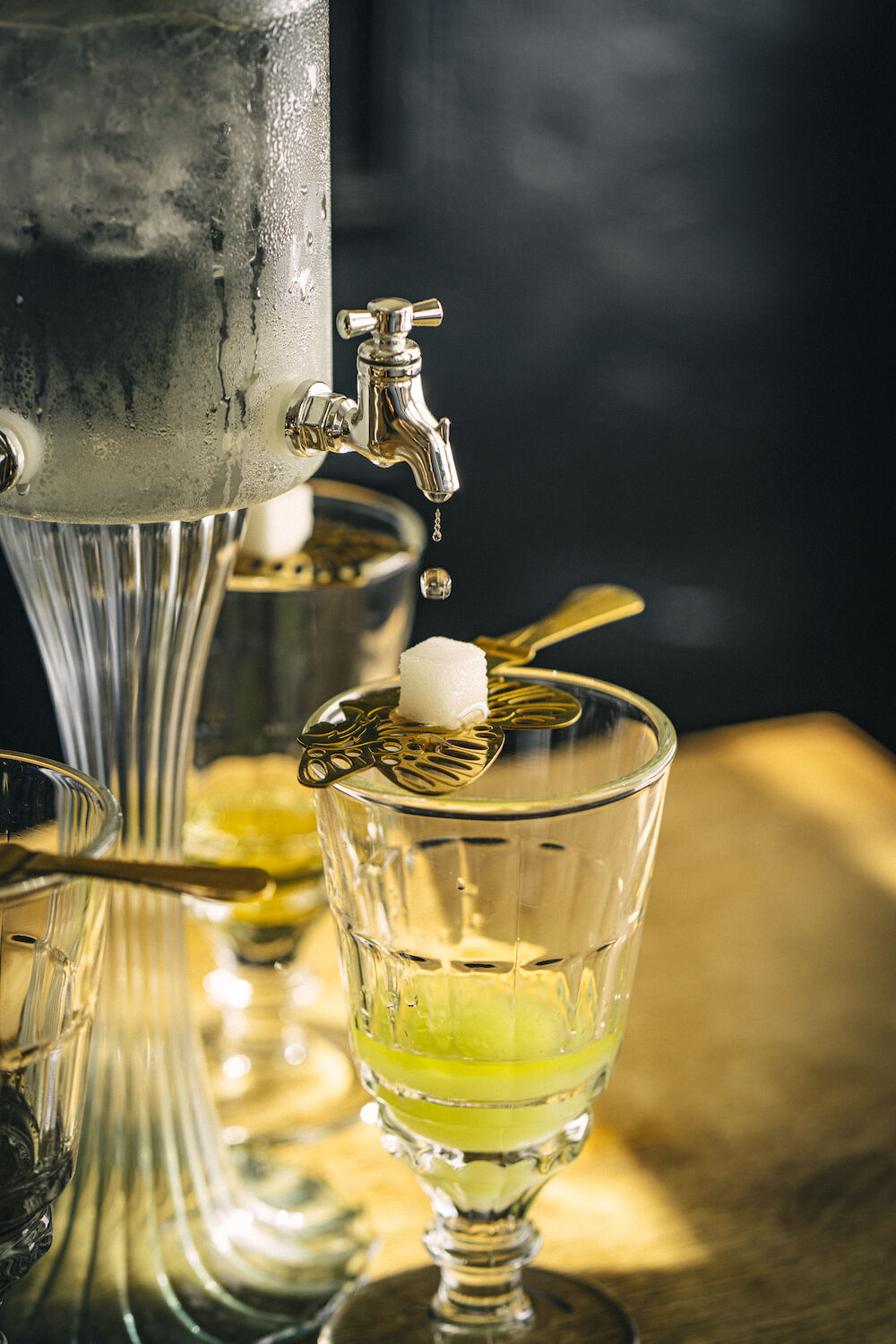
The “show” is the absinthe tower, delivered with multiple kinds of absinthe and a server who explains the whole mythical process
Photo Credit: Eric Wolfinger
The other spirit is absinthe. When opened, Wormwood was billed as “San Diego’s first absinthe bar.” That’s a tad reductive, because the kitchen is loaded with talent. Group culinary director Janina Garay and executive chef Danny Romero worked together at Michelin-star Addison, and before that, the now-defunct James Beard-nominated Bracero—and their French-Mexican menu is special. But at almost every table in the 1,700 square-foot restaurant are absinthe towers—ornate water challices with four spouts on each side. Servers crouch to explain how to absinthe: place a sugar cube on a brass absinthe spoon, slowly release a trickle of water, which dissolves the cube into the absinthe below. In the glass, a white cloud blooms (called “louching,” which just sounds devious).
Drinking absinthe, of course, causes you to hallucinate and descend into madness, and the only way out is to write terrible poetry. None of this is true, but the peyote-adjacent myths around the “green fairy” sure are fun. The spirit, originating in Switzerland, is just a potent, distinctive combo of wormwood, anise, and fennel. It tastes like intense and dynamic black licorice, if black licorice had the ability to gleefully impair your decision making and turn your motor skills into noodles.
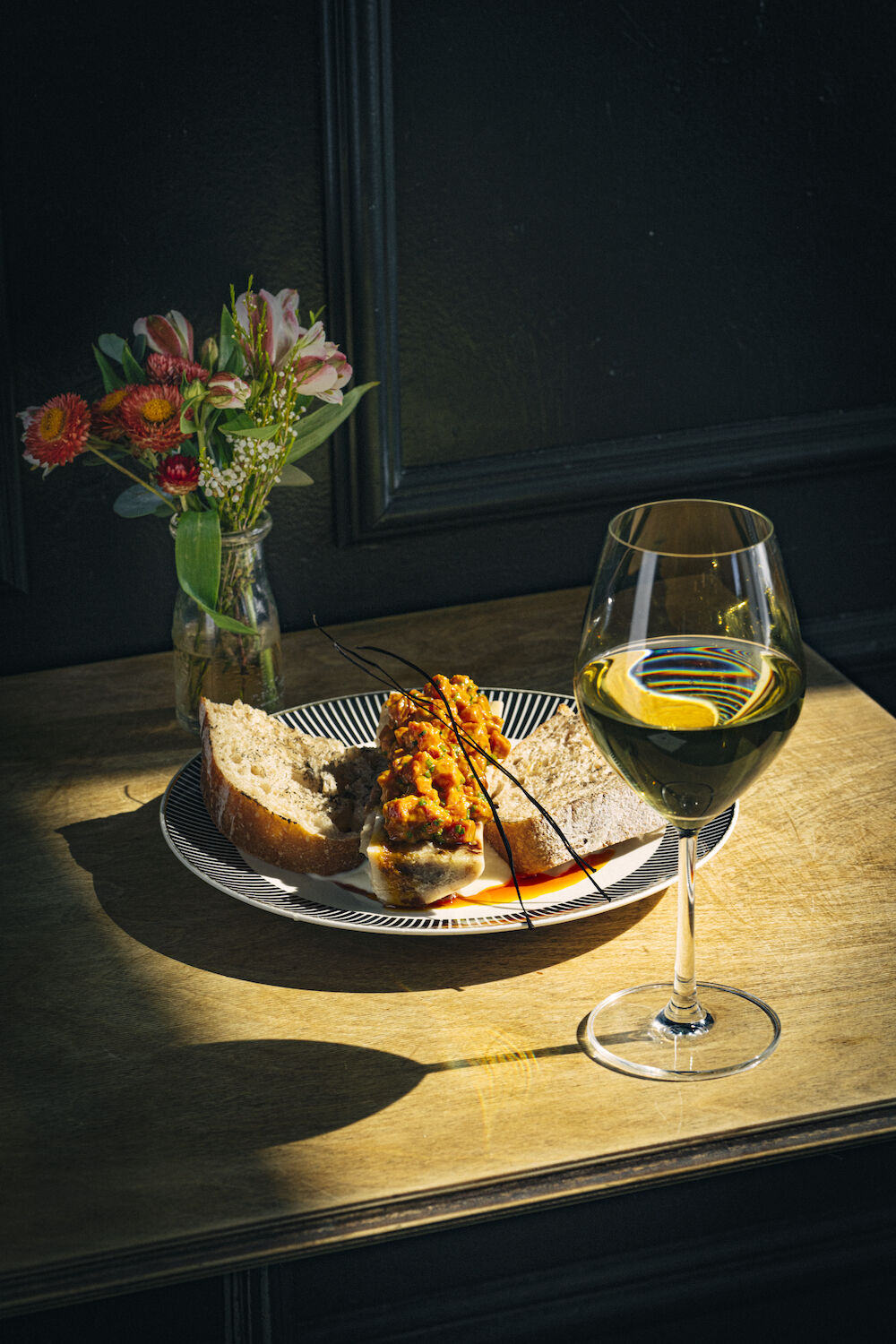
Wagyu tartare with roasted bone marrow
Photo Credit: Eric Wolfinger
The rumors about the bone marrow are true—it’s luminous. Actually, it’s a Wagyu tartare, tossed with Dijon, marrow (aka meat butter), and guajillo chiles served on the roasted bone. The marrow and mustard replace the creaminess traditionally provided by egg yolk, and this dish perfectly shows off the handshake between French and Mexican flavors that is the defining characteristic of Wormwood— Franco sauces, Baja flair.
The shocking thing about dining here is not just how tiny it is—like bistros in San Francisco or New York, the mere notion of elbow room is financially reckless. They also have to maximize guests-per-inch. Feet kicker- uppers may struggle, but the eating-on-top-of-strangers experience has an enlivening effect. It mandates a conviviality, a togetherness for everyone in the room.
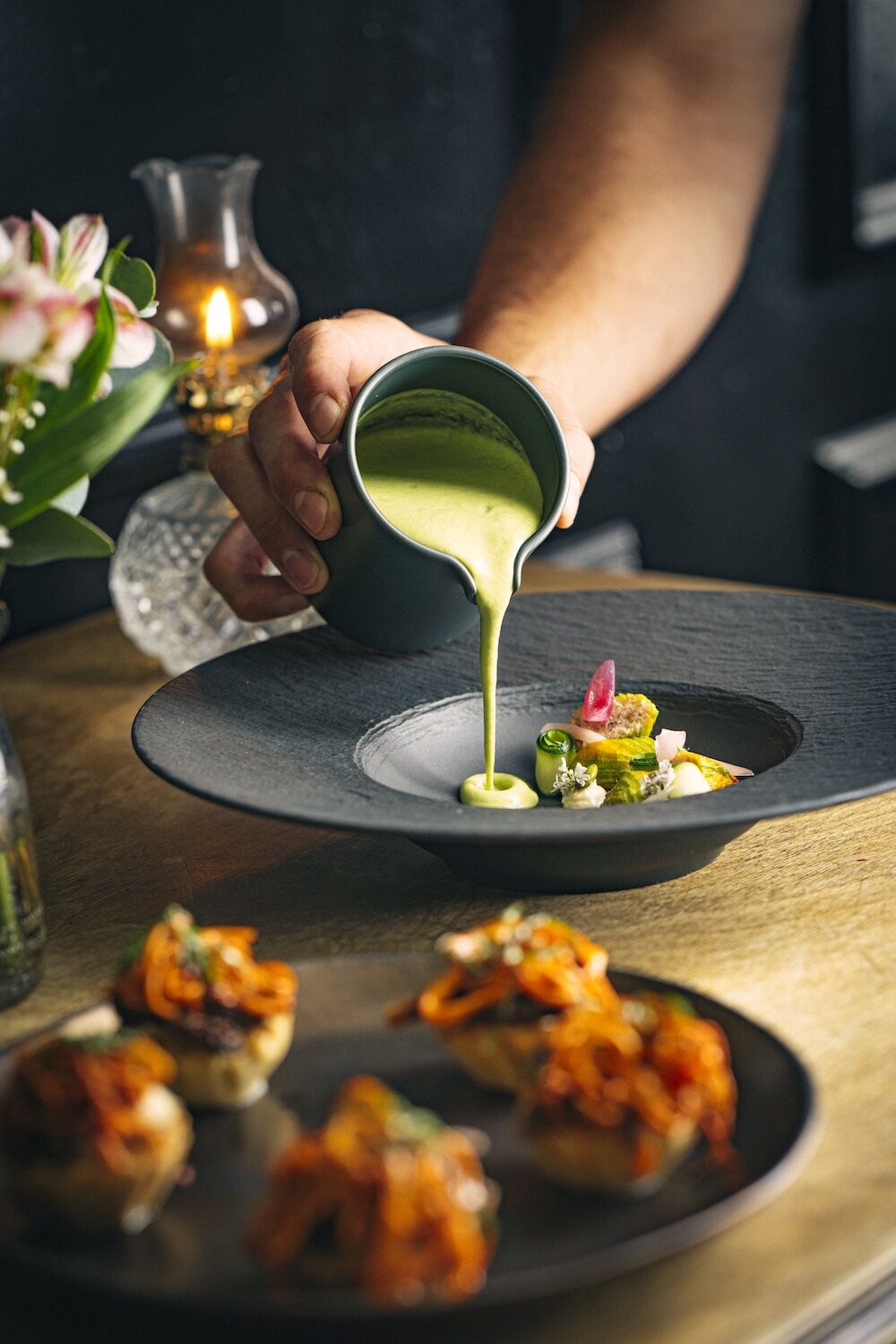
Zucchini velouté with crab-mascarpone stuffed squash blossoms, orange crema, pickled ramps, and pepita oil
Photo Credit: Eric Wolfinger
The real shock is how, in this smallness, they prioritize tableside presentations—like the pouring of the zucchini veloute, poured form decanter into a bowl with squash blossoms stuffed with crab and mascarpone, pickled ramps, orange crema, and pepita oil. The secret is that they don’t make their chicken stock for this with roasted bones; instead, they blanche them to rid impurities, then simmer for six hours. The luscious, tomatillo aguachile for the fruits de mer is also poured tableside—over lime-cured scallops and local kampachi, pickled red onions, peanuts soaked in Calabrian chile oil, and trout roe.
Now that we’re all plant-curious, Romero gives us a few winners. First, a duo of beets: red (simmered in thyme, orange, and black pepper) and golden (roasted in star anise, cinnamon, and juniper), plated with baby Pishori pistachios (a spendy treat on the pistachio scene, and worth it), avocado puree, mint, lemon vinaigrette, hyssop, cara cara orange, and dusted in raspberry powder.
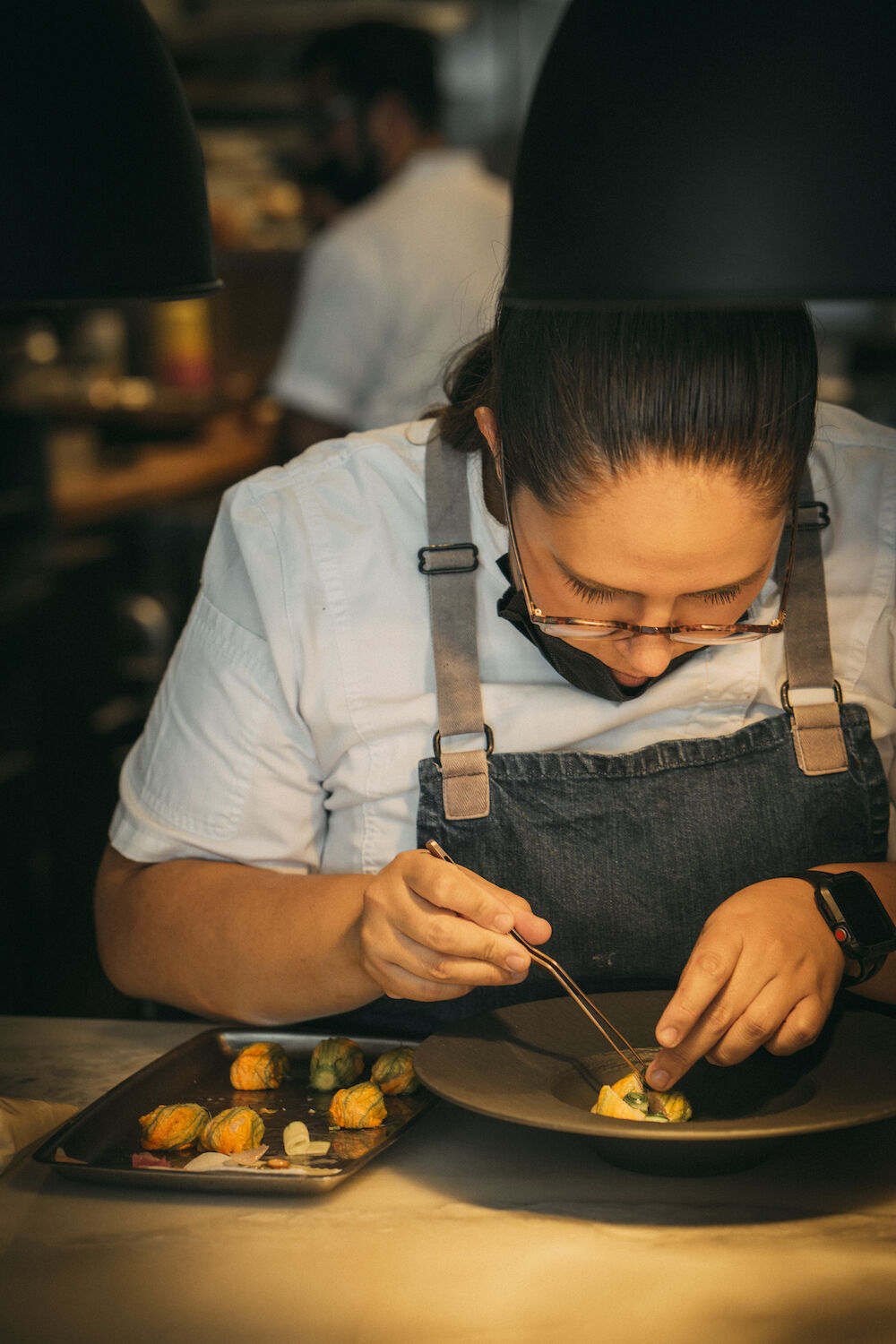
Culinary director Janina Garay in full tweezer mode
Photo Credit: Eric Wolfinger
Then the wild mushroom tartlets, stuffed with caramelized onions, pea butter, and potato puree, topped with mushrooms (golden thread and enoki), dusted in lime zest and mint. The orange golden threads look like tiny breadsticks, or pasta made of Tang.
Their pastas are a study in how French cream sauces have the ability to nullify the human restraint mechanism and how Wormwood tweaks classics. For their linguini and clams, they make a hollandaise from lobster shells, toss it with sea beans and espelette (the famed French pepper), and finish with a tomatillo consomme to cut the heaviness. The smoked duck confit is the star—house-cured duck smoked over mesquite, slow-cooked and shredded, served with Parisian gnocchi (no potato, and lighter) tossed with a banana beurre blanc.
Banana? In a cream sauce? You bet. Why not? Have fun. Try it. And they don’t overdo it, so it works.
Chefs Danny and his brother Dante (Wormwood’s chef de cuisine) used to host one of San Diego’s top underground dinner series, called Tortoise. If you look at Danny’s chef coat, you’ll notice a little turtle. And one of Wormwood’s excellent entrees came from Tortoise—the chicken roulade. Breast and tenderloins are wrapped in chicken skin, sous-vide, then flash fried and served with a sauce escabeche (basically the pickled veggies you get at a taco shop), sweet-sour carrots, and roasted cauliflower, all finished with wine and cream. Hard to know if the halibut is fantastic or if brown butter is just the answer to life. Specifically, it gets a celery root puree and hazelnut-and- brown butter sauce along with a red grape and caper salsa.
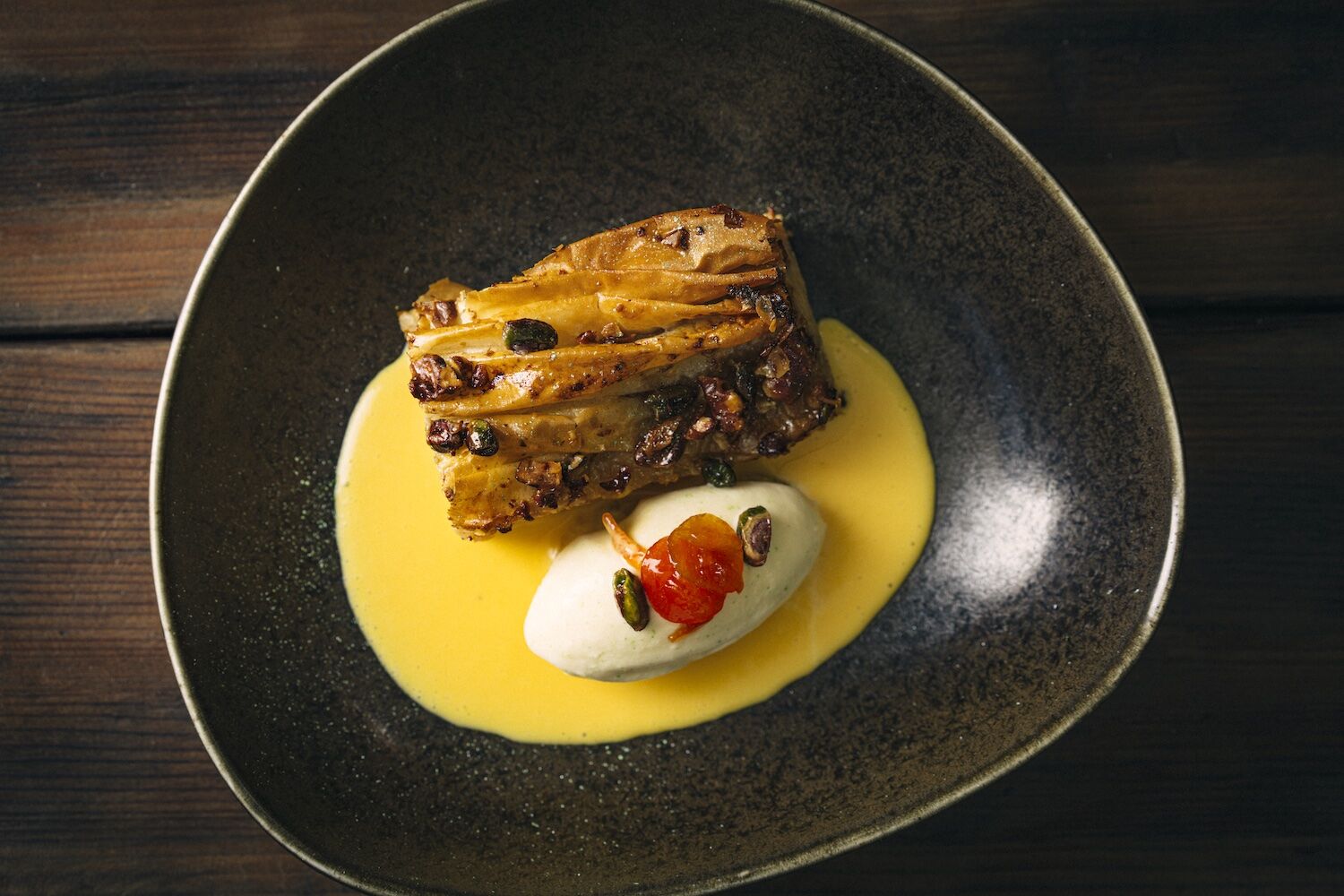
Crinkle cake—a hybrid of baklava and cheesecake—in saffron creme anglaise
Photo Credit: Eric Wolfinger
Nearly everything they have is good to excellent: the flavors, the execution, the presentation, the booze, the service, the pretty little plates. My one complaint about the current menu is that it is a river of heavy cream—an unrepentant estuary of post-cow indulgence. Mexican influence aside, this is some of that old-school French cooking, when thick and luscious sauces are treated like duct tape: the fix for everything. While that may be true, some patrons may crave a few lighter dishes.
PARTNER CONTENT
For dessert, you must try the cheeseklava: a crinkle cake that is a wonderful mutant of baklava and cheesecake—with the papery-thin pastry up top and the cake below—with a shallow pool of saffron creme anglaise and candied kumquats. If you’re more of a berries ‘n’ cream sort, go for the Baba a l’absinthe—a riff on the classic French rum cake. Wormwood soaks their cake in absinthe and serves it tableside with creme fraiche- flavored whip cream, fresh berries, and honeycomb toffee.
At Wormwood, the absinthe is the angle, the catch, and the elevator pitch that gets you in the door. The rest of it is why you won’t want to leave.
